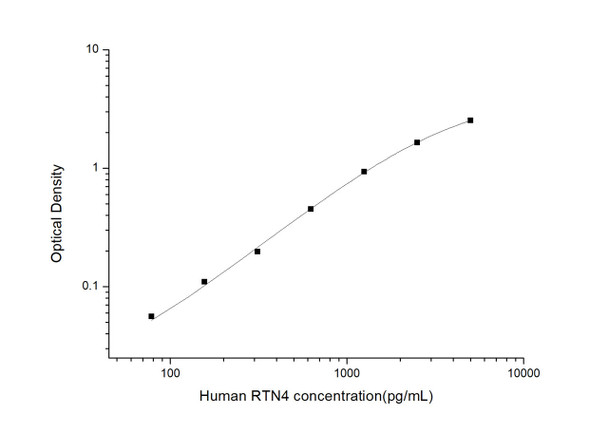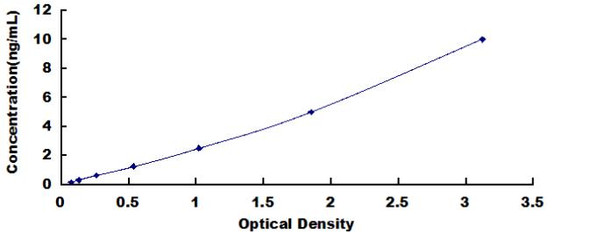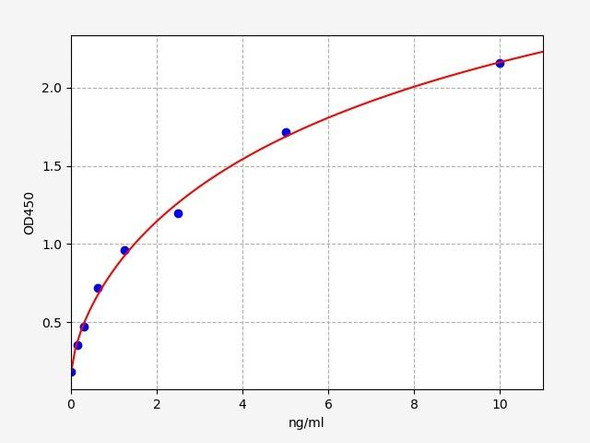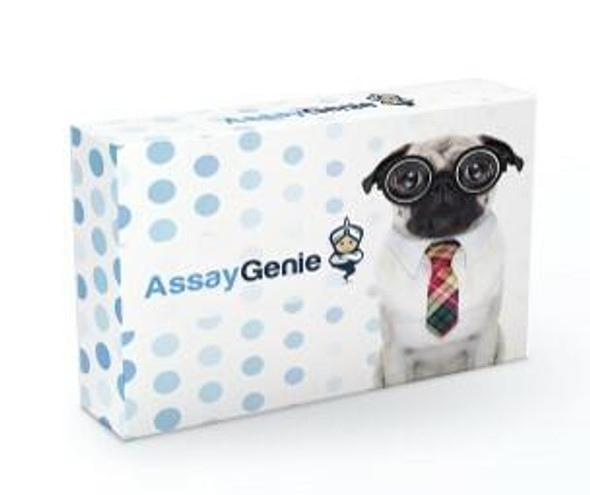Human Neuroscience ELISA Kits
Human RTN4 (Reticulon 4) ELISA Kit (HUES03375)
- SKU:
- HUES03375
- Product Type:
- ELISA Kit
- Size:
- 96 Assays
- Uniprot:
- Q9NQC3
- Sensitivity:
- 46.88pg/mL
- Range:
- 78.13-5000pg/mL
- ELISA Type:
- Sandwich
- Reactivity:
- Human
- Sample Type:
- Serum, plasma and other biological fluids
- Research Area:
- Neuroscience
Description
| Assay type: | Sandwich |
| Format: | 96T |
| Assay time: | 4.5h |
| Reactivity: | Human |
| Detection Method: | Colormetric |
| Detection Range: | 78.13-5000 pg/mL |
| Sensitivity: | 46.88 pg/mL |
| Sample Volume Required Per Well: | 100µL |
| Sample Type: | Serum, plasma and other biological fluids |
| Specificity: | This kit recognizes Human RTN4 in samples. No significant cross-reactivity or interference between Human RTN4 and analogues was observed. |
This ELISA kit uses Sandwich-ELISA as the method. The micro ELISA plate provided in this kit has been pre-coated with an antibody specific to Human RTN4. Standards or samples are added to the appropriate micro ELISA plate wells and combined with the specific antibody. Then a biotinylated detection antibody specific for Human RTN4 and Avidin-Horseradish Peroxidase (HRP) conjugate are added to each micro plate well successively and incubated. Free components are washed away. The substrate solution is added to each well. Only those wells that contain Human RTN4, biotinylated detection antibody and Avidin-HRP conjugate will appear blue in color. The enzyme-substrate reaction is terminated by adding Stop Solution and the color turns yellow. The optical density (OD) is measured spectrophotometrically at a wavelength of 450 nm ± 2 nm. The OD value is proportional to the concentration of Human RTN4. The concentration of Human RTN4 in samples can be calculated by comparing the OD of the samples to the standard curve.
| UniProt Protein Function: | Nogo: Developmental neurite growth regulatory factor with a role as a negative regulator of axon-axon adhesion and growth, and as a facilitator of neurite branching. Regulates neurite fasciculation, branching and extension in the developing nervous system. Involved in down-regulation of growth, stabilization of wiring and restriction of plasticity in the adult CNS. Regulates the radial migration of cortical neurons via an RTN4R-LINGO1 containing receptor complex. Isoform 2 reduces the anti-apoptotic activity of Bcl-xl and Bcl-2. This is likely consecutive to their change in subcellular location, from the mitochondria to the endoplasmic reticulum, after binding and sequestration. Isoform 2 and isoform 3 inhibit BACE1 activity and amyloid precursor protein processing. 6 isoforms of the human protein are produced by alternative splicing. |
| UniProt Protein Details: | Protein type:Membrane protein, integral; Membrane protein, multi-pass; Cell development/differentiation; Motility/polarity/chemotaxis; Endoplasmic reticulum; Inhibitor Chromosomal Location of Human Ortholog: 2p16. 3 Cellular Component: cell projection; cell soma; endoplasmic reticulum; plasma membrane; integral to endoplasmic reticulum membrane; nuclear envelope; intracellular Molecular Function:protein binding Biological Process: regulation of apoptosis; nerve growth factor receptor signaling pathway; cerebral cortex radial glia guided migration; apoptosis; axonal fasciculation; negative regulation of axonogenesis; negative regulation of axon extension; angiogenesis; negative regulation of cell growth; regulation of axonogenesis; regulation of cell migration |
| NCBI Summary: | This gene belongs to the family of reticulon encoding genes. Reticulons are associated with the endoplasmic reticulum, and are involved in neuroendocrine secretion or in membrane trafficking in neuroendocrine cells. The product of this gene is a potent neurite outgrowth inhibitor which may also help block the regeneration of the central nervous system in higher vertebrates. Alternatively spliced transcript variants derived both from differential splicing and differential promoter usage and encoding different isoforms have been identified. [provided by RefSeq, Jul 2008] |
| UniProt Code: | Q9NQC3 |
| NCBI GenInfo Identifier: | 17369290 |
| NCBI Gene ID: | 57142 |
| NCBI Accession: | Q9NQC3. 2 |
| UniProt Secondary Accession: | Q9NQC3,O94962, Q7L7Q5, Q7L7Q6, Q7L7Q8, Q8IUA4, Q96B16 Q9BXG5, Q9H212, Q9H3I3, Q9UQ42, Q9Y293, |
| UniProt Related Accession: | Q9NQC3 |
| Molecular Weight: | 108,450 Da |
| NCBI Full Name: | Reticulon-4 |
| NCBI Synonym Full Names: | reticulon 4 |
| NCBI Official Symbol: | RTN4 |
| NCBI Official Synonym Symbols: | ASY; NSP; NOGO; NOGOC; RTN-X; NOGO-A; NSP-CL; Nogo-B; Nogo-C; RTN4-A; RTN4-C; RTN4-B1; RTN4-B2; NI220/250; Nbla00271; Nbla10545 |
| NCBI Protein Information: | reticulon-4; foocen; Human NogoA; reticulon 5; My043 protein; neurite outgrowth inhibitor; neurite growth inhibitor 220; neuroendocrine-specific protein C homolog |
| UniProt Protein Name: | Reticulon-4 |
| UniProt Synonym Protein Names: | Foocen; Neurite outgrowth inhibitor; Nogo protein; Neuroendocrine-specific protein; NSP; Neuroendocrine-specific protein C homolog; RTN-x; Reticulon-5 |
| Protein Family: | Reticulon |
| UniProt Gene Name: | RTN4 |
| UniProt Entry Name: | RTN4_HUMAN |
As the OD values of the standard curve may vary according to the conditions of the actual assay performance (e. g. operator, pipetting technique, washing technique or temperature effects), the operator should establish a standard curve for each test. Typical standard curve and data is provided below for reference only.
| Concentration (pg/mL) | O.D | Average | Corrected |
| 5000 | 2.573 2.627 | 2.6 | 2.52 |
| 2500 | 1.71 1.728 | 1.719 | 1.639 |
| 1250 | 1.031 0.995 | 1.013 | 0.933 |
| 625 | 0.513 0.549 | 0.531 | 0.451 |
| 312.5 | 0.29 0.266 | 0.278 | 0.198 |
| 156.25 | 0.191 0.189 | 0.19 | 0.11 |
| 78.13 | 0.13 0.142 | 0.136 | 0.056 |
| 0 | 0.071 0.089 | 0.08 | -- |
Precision
Intra-assay Precision (Precision within an assay): 3 samples with low, mid range and high level Human RTN4 were tested 20 times on one plate, respectively.
Inter-assay Precision (Precision between assays): 3 samples with low, mid range and high level Human RTN4 were tested on 3 different plates, 20 replicates in each plate.
| Intra-assay Precision | Inter-assay Precision | |||||
| Sample | 1 | 2 | 3 | 1 | 2 | 3 |
| n | 20 | 20 | 20 | 20 | 20 | 20 |
| Mean (pg/mL) | 230.37 | 531.50 | 2471.42 | 237.21 | 487.64 | 2713.10 |
| Standard deviation | 12.90 | 28.81 | 114.67 | 16.08 | 19.85 | 134.57 |
| C V (%) | 5.60 | 5.42 | 4.64 | 6.78 | 4.07 | 4.96 |
Recovery
The recovery of Human RTN4 spiked at three different levels in samples throughout the range of the assay was evaluated in various matrices.
| Sample Type | Range (%) | Average Recovery (%) |
| Serum (n=5) | 86-99 | 91 |
| EDTA plasma (n=5) | 87-98 | 93 |
| Cell culture media (n=5) | 95-109 | 100 |
Linearity
Samples were spiked with high concentrations of Human RTN4 and diluted with Reference Standard & Sample Diluent to produce samples with values within the range of the assay.
| Serum (n=5) | EDTA plasma (n=5) | Cell culture media (n=5) | ||
| 1:2 | Range (%) | 94-110 | 90-106 | 95-107 |
| Average (%) | 101 | 97 | 101 | |
| 1:4 | Range (%) | 93-106 | 81-92 | 88-101 |
| Average (%) | 100 | 86 | 93 | |
| 1:8 | Range (%) | 90-104 | 86-99 | 84-95 |
| Average (%) | 96 | 91 | 90 | |
| 1:16 | Range (%) | 90-107 | 87-100 | 82-94 |
| Average (%) | 98 | 92 | 89 |
An unopened kit can be stored at 4°C for 1 month. If the kit is not used within 1 month, store the items separately according to the following conditions once the kit is received.
| Item | Specifications | Storage |
| Micro ELISA Plate(Dismountable) | 8 wells ×12 strips | -20°C, 6 months |
| Reference Standard | 2 vials | |
| Concentrated Biotinylated Detection Ab (100×) | 1 vial, 120 µL | |
| Concentrated HRP Conjugate (100×) | 1 vial, 120 µL | -20°C(shading light), 6 months |
| Reference Standard & Sample Diluent | 1 vial, 20 mL | 4°C, 6 months |
| Biotinylated Detection Ab Diluent | 1 vial, 14 mL | |
| HRP Conjugate Diluent | 1 vial, 14 mL | |
| Concentrated Wash Buffer (25×) | 1 vial, 30 mL | |
| Substrate Reagent | 1 vial, 10 mL | 4°C(shading light) |
| Stop Solution | 1 vial, 10 mL | 4°C |
| Plate Sealer | 5 pieces | |
| Product Description | 1 copy | |
| Certificate of Analysis | 1 copy |
- Set standard, test sample and control (zero) wells on the pre-coated plate and record theirpositions. It is recommended to measure each standard and sample in duplicate. Note: addall solutions to the bottom of the plate wells while avoiding contact with the well walls. Ensuresolutions do not foam when adding to the wells.
- Aliquot 100µl of standard solutions into the standard wells.
- Add 100µl of Sample / Standard dilution buffer into the control (zero) well.
- Add 100µl of properly diluted sample (serum, plasma, tissue homogenates and otherbiological fluids) into test sample wells.
- Cover the plate with the sealer provided in the kit and incubate for 90 min at 37°C.
- Aspirate the liquid from each well, do not wash. Immediately add 100µL of BiotinylatedDetection Ab working solution to each well. Cover the plate with a plate seal and gently mix. Incubate for 1 hour at 37°C.
- Aspirate or decant the solution from the plate and add 350µL of wash buffer to each welland incubate for 1-2 minutes at room temperature. Aspirate the solution from each well andclap the plate on absorbent filter paper to dry. Repeat this process 3 times. Note: a microplatewasher can be used in this step and other wash steps.
- Add 100µL of HRP Conjugate working solution to each well. Cover with a plate seal andincubate for 30 min at 37°C.
- Aspirate or decant the solution from each well. Repeat the wash process for five times asconducted in step 7.
- Add 90µL of Substrate Reagent to each well. Cover with a new plate seal and incubate forapproximately 15 min at 37°C. Protect the plate from light. Note: the reaction time can beshortened or extended according to the actual color change, but not by more than 30min.
- Add 50 µL of Stop Solution to each well. Note: Adding the stop solution should be done inthe same order as the substrate solution.
- Determine the optical density (OD value) of each well immediately with a microplate readerset at 450 nm.






